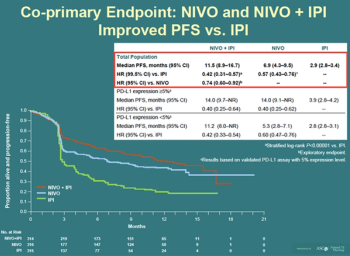
Tracking tumor DNA in the blood of early breast cancer patients following surgery predicted relapse nearly 8 months earlier than conventional imaging.

Your AI-Trained Oncology Knowledge Connection!


Tracking tumor DNA in the blood of early breast cancer patients following surgery predicted relapse nearly 8 months earlier than conventional imaging.

A large study found that while the risk of dying from breast cancer after a DCIS diagnosis is quite low, it is on par with that of women diagnosed with small, invasive breast tumors, and that aggressive DCIS treatment does not produce better results.

A complex high-dose combination therapy is tolerable and effective in patients with aggressive B-cell lymphoma that has spread to the central nervous system.

Warfarin and a low molecular-weight heparin produced similar results in reducing major blood clots in cancer patients treated for acute venous thromboembolism.

A basket trial of patients with various nonmelanoma BRAF-mutated cancers has shown that additional tumor types may also be responsive to vemurafenib.

Testing women for non-BRCA gene mutations that can confer breast or ovarian cancer risk has clinical management consequences for both the women and their family members.

While the risk of a new treatment-related cancer diagnosis after childhood is known, a new study now shows that this risk remains into the fifth and sixth decade of life.

Hypofractionated radiation therapy results in less toxicity and provides a better quality of life compared with conventional whole-breast irradiation, according to two recent studies.

Adding chemotherapy to hormonal therapy in men with metastatic hormone-sensitive prostate cancer increased improved overall survival by 13.6 months.

According to a recent study, the use of oral birth control pills has prevented 200,000 cases of endometrial cancer over the last 10 years.

A new study found that in patients treated for oropharyngeal cancer, the detection of HPV16 DNA via an oral rinse could be a sign of poor prognosis.

A pair of studies suggest that aromatase inhibitors and bisphosphonates can each improve survival for postmenopausal women with early breast cancer.

Two trials reported marginal or no improvement in survival with nodal irradiation in early breast cancer patients, though reductions were seen in recurrence.

Researchers have identified a subset of six biomarkers that together may predict the risk of more aggressive prostate cancer among African American men.

Using a novel imaging technique, researchers have discovered that differences in HER2 homodimers on breast cancer cells may point toward functional differences, with possible implications for metastasis and drug resistance.

Researchers have discovered that using progesterone in the treatment of breast cancer could result in better clinical outcomes.

Occult maternal malignancies can be detected through noninvasive prenatal testing (NIPT), according to the results of a small preliminary study.

[18F]FDG-PET/CT could predict response in patients with metastatic HER2-positive breast cancer treated with lapatinib plus trastuzumab.

While having an advance plan for end-of-life decisions has increased in cancer patients, aggressive treatments near the end of life continue to occur.

The management of patients with localized prostate cancer has improved to meet clinical guidelines, according to a new study.

Though the United States has seen a decrease in death rates from colorectal cancer, three regions, or "hotspots," continue to experience high rates.

This slide show highlights some of the top studies and news on cancer to come out of the 2015 American Society of Clinical Oncology (ASCO) Annual Meeting, held in Chicago.

The FDA has granted a priority review for MM-398 as a second-line treatment for metastatic pancreatic cancer after the drug demonstrated improved survival.

Frequent consumers of citrus fruits were found to have an elevated risk of malignant melanoma.

Detection of cervical lesions among young women has decreased since the introduction of HPV vaccines and guidelines calling for reduced cervical cancer screening.

A study of men taking PDE5 inhibitors found a small but significant increase in the incidence of malignant melanoma, though the association may not be causal.

The presence of an abdominal blood clot may be a sign of cancer and may also be associated with poor survival for patients with pancreatic or liver cancers.

Detection of antibodies against HPV16 in the blood of patients with HPV-positive oropharyngeal carcinoma correlates with improved survival.

Utilization of breast-conserving therapy has increased over the years in early breast cancer but there are still barriers, including socioeconomic factors.

PSA-based screening for prostate cancer among men older than 50 has decreased since the 2012 USPSTF recommendations.